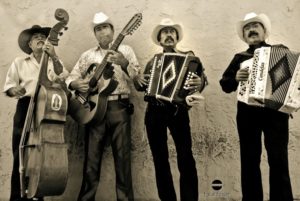Mexican Country Music
 Musica Norteña literally translates to northern music or music of the north, referring to the northern geographic region of Mexico that encompasses the states of Sonora, Chihuahua, Coahuila, Nuevo Leon, Tamaulipas, Sinaloa and Durango. It was in these states that the music that we know of today as norteño music originated from.
Musica Norteña literally translates to northern music or music of the north, referring to the northern geographic region of Mexico that encompasses the states of Sonora, Chihuahua, Coahuila, Nuevo Leon, Tamaulipas, Sinaloa and Durango. It was in these states that the music that we know of today as norteño music originated from.
A Brief History
During the reign of Emperor Maximilian I from 1864 to 1867 many culturally European things were brought over to Mexico, specifically from the emperor’s home country of Austria. Among them was the art of making “German-style” beer and various musical instruments along with their respective musical styles such as polka and the waltz. After Maximilian’s reign was over, many Eupoeans migrated north from Central Mexico and populated the rural desert landscape. Once there they mingled with the local Mexican population and after a while a unique genre of polka-waltz emerged. This new genre heavily featured the accordion, bajo sexto (sixth bass) and guitar and was played by a conjunto (small group), taking lyrical inspiration from their humble and sometimes rough country lives.
The Music Itself
The music itself sounds like traditional polka music as heard in the Czech Republic but with added Spanish vocals and sometimes virtuoso accordion playing. The music is upbeat and generally danced to with a partner.
Like the traditional country and folk music of the United States, norteño music speaks to the heart of those who listen, with lyrics dealing with many common human emotions. It is a musical genre from the people for the people, meaning that oftentimes the music features lyrics relating to the countryside where people work in agriculture and need to be tough to survive.
Sometimes the subjects include heartbreak, violence, appreciation of nature, the retelling of history and even singing about drug dealers.
One song that comes to mind that easily conjures up vivid images of heartbreak is the song “Las casas de madera” by legend Ramón Ayala. In the song the speaker attributes feelings of sadness onto wooden houses being moved by the wind after a lover has left the speaker (and the house) alone. The speaker paints a dreary picture where the wind makes houses creak and dark clouds shroud the sunlight.
You would imagine that these lyrics would be played accompanied by a lonely acoustic guitar sung by a melancholy singer-songwriter, but the reality is that when sung by a conjunto there’s a
sense of stoicism where pity would otherwise be. Whether the lyrics are sad or not, the music makes you wanna get up and dance with your partner.
The Instruments
What makes this type of music distinct is at its foundation, it uses some very unique instruments. As stated earlier, certain instruments were brought over from Europe and adapted to suit the Mexican style. Among the few that made the greatest impact in the music of Mexico are the accordion and the bajo sexto. These two instruments are unmistakably recognizable and integral to norteño music.
The accordion
It’s interesting when you think about how well-known the accordion is yet it’s rarely played in the United States, but if you drive south and cross the border, it would seem as if it was the Mexican national instrument.
What makes the accordion so special is that it has keys like that of a piano but it is actually a woodwind instrument that you strap on to your chest like a backwards backpack. The instrument is made out of wood and uses bellows to force air through free reeds inside. The result is a very full, harmonic sound that one can alter drastically depending on such things as air compression, keys pressed and personal finesse.
The bajo sexto
Also known as the sixth bass, the bajo sexto is an instrument in the guitar family. It has 12 strings and is similar in size to a cello, but compared to a guitar, the body is deeper, the neck is shorter and the strings are thicker (it being a bass). This distinct sounding “guitar” is very recognizable in the sound it produces as well as in its appearance, which is often decorated with brilliant designs on the body.
Final Thoughts
Norteño music is a special genre of music because it sounds unconventional, given the fact that the only other places you’ll hear similar sounding music would be in Southern Texas (Tejano music) and in some parts of Europe (where it is a style of folk music).
Although not unique in this sense, norteño music serves as a mirror, reflecting what the country is going through at any given moment. Whether Mexico is going through political turmoil, drug wars, poverty, etc., no subject is beyond the reach of norteño songwriters (unknowingly) adding
a small entry to the history of the country. Norteño music provides the ability to be able to understand history from a deeper, more personal and music-oriented perspective than looking through a textbook.
Some great artists include: Ramon Ayala, Los Tigres Del Norte, Los Relámpagos del Norte, Los Invasores de Nuevo León, Los Cadetes de Linare, and Carlos y José.
